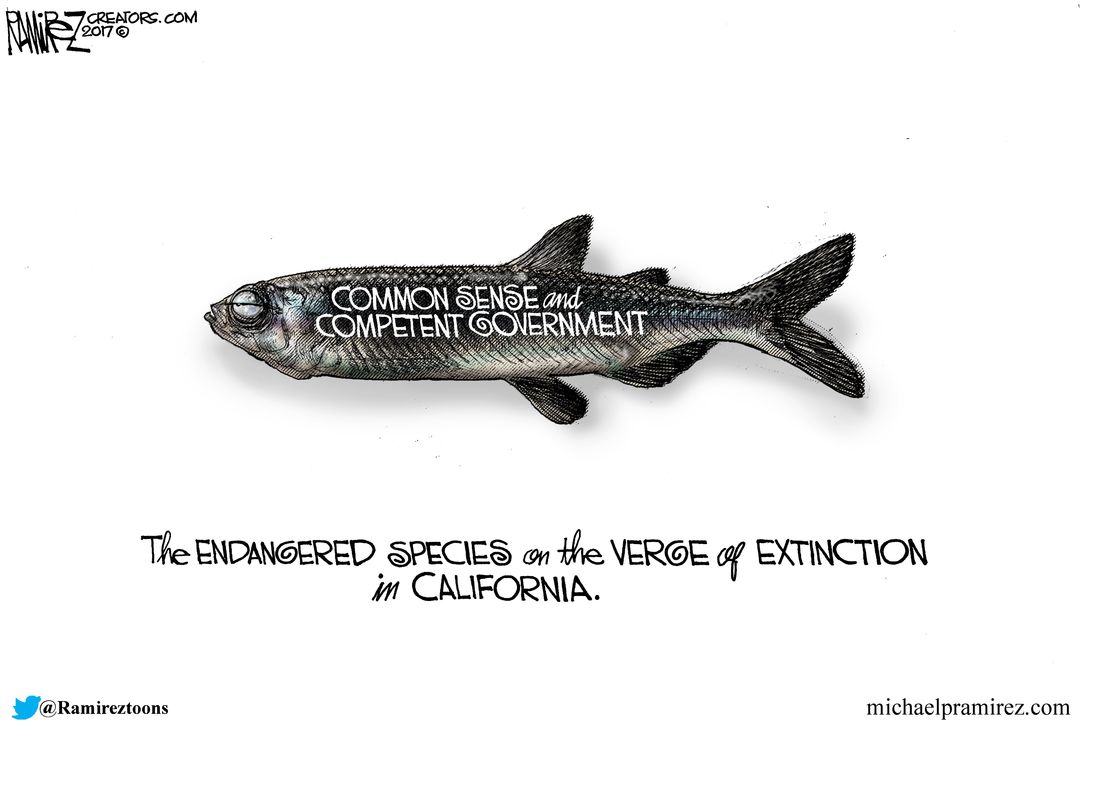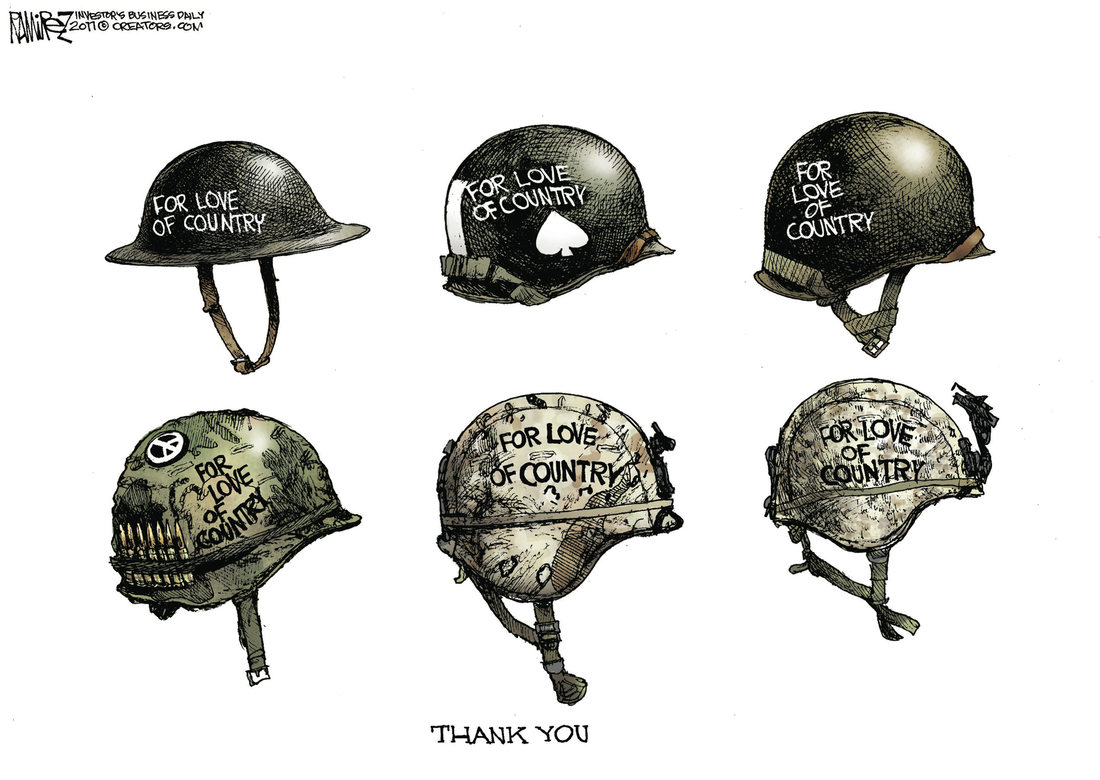Welcome to the World of Pulitzer Prize Winning Political Cartoonist Michael P. Ramirez
Endangered 03-30-17
|
Just released! Fine Giclee prints -signed & numbered by Michael P. Ramirez. Tolerance and Free Speech, Capone's Vault limited to just 25. For Love of Country is limited to 100. Prints are priced at $200 and will be accompanied with a certificate of authenticity from the artist.
|
California Vows to Continue Tightening Air Regulations Despite Trump Order
State remains committed to exceeding targets of Clean Power Plan
JIM CARLTON and CORINNE RAMEY
March 28, 2017
As the Trump administration starts to roll back air regulations on industry, California vowed to keep moving toward tighter rules. read more (subscription required)
State remains committed to exceeding targets of Clean Power Plan
JIM CARLTON and CORINNE RAMEY
March 28, 2017
As the Trump administration starts to roll back air regulations on industry, California vowed to keep moving toward tighter rules. read more (subscription required)
California won’t budge on tough auto regulations
Brent Snavely , Detroit Free Press March 24, 2017
Just weeks after President Donald Trump signaled he's ready to roll back tough federal vehicle fuel standards, California on Friday affirmed that it won't budge an inch on its own tough standards.
The California Air Resources Board reaffirmed its own set of regulatory standards for the automotive industry, setting it and 12 other mostly East and West Coast states that follow its lead on a different path than the rest of the nation.
The 16-member board of California regulators voted unanimously to reaffirm its existing standards for model years 2022-25 for zero emission vehicle sales and greenhouse gas emissions in California despite pleas from the industry for changes.
The board also decided to begin a process to consider post-2025 standards in order to fulfill state laws that mandate cuts in pollution.
"Based on extensive analysis done, the data supports the conclusion that the 2022 to 2025 model year standards are appropriate as developed," said Pippin Mader, an air resources engineer at the California Air Resources Board.
Twelve other states plus the District of Columbia effectively adopt California's rules as their own: Connecticut, Delaware, Maine, Maryland, Massachusetts, New Jersey, New York, Oregon, Rhode Island, Pennsylvania, Vermont and Washington.
CARB's refusal to budge was cheered by environmental groups but raises concerns among the auto industry that manufacturers will wind up making cars for two different automotive markets within the U.S. — one regulated by California standards and another regulated by federal standards.
Last week, the Trump administration signaled it plans to roll back national standards when it reversed a decision by the U.S. Environmental Protection Agency to stay on course with regulations through 2025. The EPA now plans to resume its review of regulations for 2021-25 model year vehicles and is widely expected to grant automakers more flexibility to meet greenhouse gas emission standards.
"What were you thinking … when you threw yourselves upon the mercy of the Trump administration to solve your problems?" Mary Nichols, CARB's chairwoman, asked auto industry representatives during the hearing in California on Friday. "Why do another review if the current program is basically OK?"
John Bozzella, president and CEO of Global Automakers, said what the auto industry has been saying repeatedly for the past year: That both federal automotive regulations and California automotive regulations adopted in 2011 are out of date and out of sync with current market conditions.
Automakers have developed cars and trucks that are far more fuel efficient than the vehicles sold a decade ago. But gas prices have remained far lower than expected and consumer demand for electric vehicles is nowhere near what regulators predicted back then.
"We agree that we need to reduce greenhouse gas emission and improve fuel economy," Bozzella said. "We agree we should be making decisions using the latest science and data. We are as committed to the goals of the one national program as we were in 2012."
Older than EPA
CARB has been regulating the West Coast state's air quality for more years than the U.S. EPA has even existed. The state, facing terrible smog issues, passed legislation in 1967 that established the agency.
The U.S. EPA wasn't formed until after 1970 as it was authorized by the Clean Air Act. The state's regulatory board has maintained a special status as a regulator of air quality because of California's lobbying power, its expertise and its historical standing. It is viewed as a global leader when it comes to air quality regulation.
The result: The automotive industry, in the U.S., must comply with three agencies: The National Highway Traffic Safety Administration that regulates fuel economy, the EPA that regulates greenhouse gas emissions in 38 states, and the CARB. read more
Brent Snavely , Detroit Free Press March 24, 2017
Just weeks after President Donald Trump signaled he's ready to roll back tough federal vehicle fuel standards, California on Friday affirmed that it won't budge an inch on its own tough standards.
The California Air Resources Board reaffirmed its own set of regulatory standards for the automotive industry, setting it and 12 other mostly East and West Coast states that follow its lead on a different path than the rest of the nation.
The 16-member board of California regulators voted unanimously to reaffirm its existing standards for model years 2022-25 for zero emission vehicle sales and greenhouse gas emissions in California despite pleas from the industry for changes.
The board also decided to begin a process to consider post-2025 standards in order to fulfill state laws that mandate cuts in pollution.
"Based on extensive analysis done, the data supports the conclusion that the 2022 to 2025 model year standards are appropriate as developed," said Pippin Mader, an air resources engineer at the California Air Resources Board.
Twelve other states plus the District of Columbia effectively adopt California's rules as their own: Connecticut, Delaware, Maine, Maryland, Massachusetts, New Jersey, New York, Oregon, Rhode Island, Pennsylvania, Vermont and Washington.
CARB's refusal to budge was cheered by environmental groups but raises concerns among the auto industry that manufacturers will wind up making cars for two different automotive markets within the U.S. — one regulated by California standards and another regulated by federal standards.
Last week, the Trump administration signaled it plans to roll back national standards when it reversed a decision by the U.S. Environmental Protection Agency to stay on course with regulations through 2025. The EPA now plans to resume its review of regulations for 2021-25 model year vehicles and is widely expected to grant automakers more flexibility to meet greenhouse gas emission standards.
"What were you thinking … when you threw yourselves upon the mercy of the Trump administration to solve your problems?" Mary Nichols, CARB's chairwoman, asked auto industry representatives during the hearing in California on Friday. "Why do another review if the current program is basically OK?"
John Bozzella, president and CEO of Global Automakers, said what the auto industry has been saying repeatedly for the past year: That both federal automotive regulations and California automotive regulations adopted in 2011 are out of date and out of sync with current market conditions.
Automakers have developed cars and trucks that are far more fuel efficient than the vehicles sold a decade ago. But gas prices have remained far lower than expected and consumer demand for electric vehicles is nowhere near what regulators predicted back then.
"We agree that we need to reduce greenhouse gas emission and improve fuel economy," Bozzella said. "We agree we should be making decisions using the latest science and data. We are as committed to the goals of the one national program as we were in 2012."
Older than EPA
CARB has been regulating the West Coast state's air quality for more years than the U.S. EPA has even existed. The state, facing terrible smog issues, passed legislation in 1967 that established the agency.
The U.S. EPA wasn't formed until after 1970 as it was authorized by the Clean Air Act. The state's regulatory board has maintained a special status as a regulator of air quality because of California's lobbying power, its expertise and its historical standing. It is viewed as a global leader when it comes to air quality regulation.
The result: The automotive industry, in the U.S., must comply with three agencies: The National Highway Traffic Safety Administration that regulates fuel economy, the EPA that regulates greenhouse gas emissions in 38 states, and the CARB. read more




